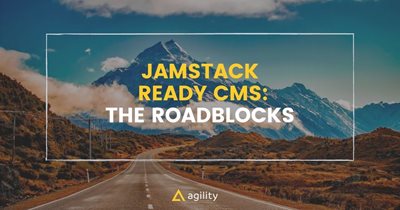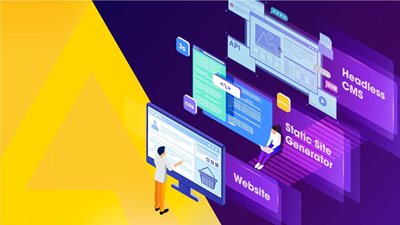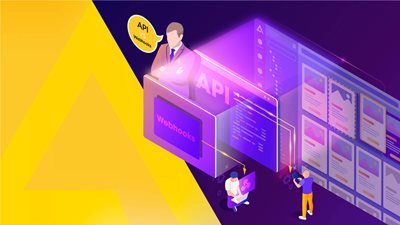JAMstack-Ready CMS: The Roadblocks
How to overcome the roadblocks that hamper JAMstack adoption.


In our experience, both marketers and developers find the benefits of JAMstack development easy to understand and implement. JAMstack sites are faster than their competitors because they’re static and served from a CDN. They’re also more secure because there’s nothing to compromise and development can be optimized. After all, every piece of the stack is independent.
JAMstack enables developers to stay nimble. In the JAMstack ecosystem, each tool, framework, and API works in sync with the other, which means that you don’t have to focus on juggling multiple technologies when building a site. Also, JAMstack bridges the gap between static and dynamic websites while keeping the advantages of static websites.
However, it seems that despite the advantages JAMstack brings, most CMSs, whether they be traditional, hybrid, or headless, still aren’t ready to adopt the JAMstack way.
Let’s see the roadblocks CMSs face when it comes to implementing JAMstack.
Why All The Hype About JAMstack?
JAMstack became popular because it represents a quick and affordable solution for marketers and solo developers to solve deployment problems. It simplifies the development process and reduces reliance on expensive or complicated tech stacks.
The genius of JAMstack lies in its simplicity. JAMstack relies on modern JavaScript frameworks and static site generators to build blazing-fast websites, which makes the difference in how well Google perceives a website. In fact, with Jamstack, many mention getting perfect scores on Google PageSpeed Insights.
Besides, JAMstack-powered static sites can be sourced with data from pretty much anywhere. From locally-stored markdown files to Google Sheets, to a headless CMS.
On the other hand, JAMstack keeps every concern separate, which enables marketing teams and developers to adopt a best-of-breed solution for each problem, giving teams almost infinite scalability.
So, JAMstacks brings improved performance, greater security, scalability, and it’s cost-effective, but what are the limitations to its adoption?
What Does JAMstack-ready Mean?
In a nutshell, a JAMstack-ready CMS is a CMS that makes content available via API, and that’s ready to plug into the JS-powered frontend. That means that a JAMstack-ready CMS is built on an API architecture from the beginning.
However, not every Java-based CMS is JAMstack-ready. To be entirely JAMstack-ready, a CMS needs to be based on client-side JavaScript, reusable APIs, and prebuilt Markup for building websites and apps.
Limitations to JAMstack Adoption
For content teams that are often less technically oriented, JAMstack can be challenging to master. Similarly, if you’re trying to add dynamic content features, chances are that you’ll end up requiring a third-party solution. By the same token, significant alterations of the presentation layer would need a developer.
Let’s take a closer look at the roadblocks to JAMstack adoption.
Difficult Content Authoring
Expecting non-technical content authors to write in markup is unrealistic, especially in a world where other feature-rich CMSs focus on simplifying content authoring. However, markup is not the sole culprit. Content relationships are also one place where JAMstack sites struggle, especially when it comes to relationships between pages or collections of assets.
Dynamic Content
In most cases, when leveraging JAMstack, if you need to add shopping carts, feedback forms, or comments, you need to add additional services to your stack, which could jeopardize your security or the stability of the site if you need to render dynamic content. This reliance in third-parties can create dependencies because you can’t fully control downtime of third-parties.
Managing Media Without a CMS Can Be a Pain
In almost all cases, managing content without a dedicated CMS can be hard. In JAMstack, if you decide to upload markdown directly to your site and link images, you’ll have a hard time because you’ll have to do all the media management yourself. A headless CMS eases your load and helps you focus on what really matters. This is particularly important if you decide to choose a website builder that doesn’t have built-in media management like Ghost.
How Agility CMS Overcomes JAMstack Limitations
For over a decade, Agility was a .NET CMS, but once we decided to support JAMstack, things changed radically. Some of our reasons for supporting JAMstack include the increased performance and reliability of statically generated sites.
Agility CMS is an API-first headless CMS that developers can connect to different third-parties and frontend frameworks to supply what they need, scaling quickly and with ease.
To solve the roadblocks we mentioned above, we’ve built a combination of CMS data source plugins and starter sites for the leading Jamstack tools: Gatsby and Next. We recommend using Gatsby or NextJS with Gatsby Cloud or Vercel respectively to circumvent all the issues related to content authoring, previewing, and dynamic content.
For instance, Gatsby sites give developers an instant preview of everything as you make changes in your CMS. Then, you can point that to your Github content repository, and it automatically rebuilds the site as you change things, making the process easier for marketers and developers alike.
Read more: Here is how you can start with Gatsby and Agility CMS.
Also, when it comes to building NextJS sites, we recommend that you use Vercel for hosting, as it gives you a robust preview mode as well as a CDN-base that makes going from local code development, to preview, and then to production, quick and easy.
Try Agility CMS for FREE and try our new Next JS Starter.
Why Agility CMS Is One of the JAMstack Pioneers
Agility CMS helps developers who need to build a foundation for their bespoke, online ecosystem and want to back their JAMstack builds in a stable, reliable headless CMS.
These are some of the main reasons Agility CMS is one of the JAMstack pioneers:
We use REST APIs or sync SDKs to interact with your content and deliver it anywhere.
- Our CMS enables developers to code things their way. We won’t dictate how your content is presented. Use one of our starters and fast-track development.
- It hosts and completely abstracts away your database, so you never have to worry about maintenance, backups, or connection strings ever again.
- We work with customers who want to adopt JAMstack despite having large, monolithic websites. Using Agility, they’re shifting to a JAMstack setup page-by-page, using JAMStack to improve the more essential sections of their sites selectively.
- We have devised a content architecture to help brands manage their digital content.
If you want to learn more about Agility CMS and JAMstack, see our webinar about how Agility works as a JAMstack CMS.
Keep Reading:
If you want to learn more about JAMstack make sure to check out our webinars and read these articles:

About the Author
Joel is CTO at Agility. His first job, though, is as a father to 2 amazing humans.
Joining Agility in 2005, he has over 20 years of experience in software development and product management. He embraced cloud technology as a groundbreaking concept over a decade ago, and he continues to help customers adopt new technology with hybrid frameworks and the Jamstack. He holds a degree from The University of Guelph in English and Computer Science. He's led Agility CMS to many awards and accolades during his tenure such as being named the Best Cloud CMS by CMS Critic, as a leader on G2.com for Headless CMS, and a leader in Customer Experience on Gartner Peer Insights.
As CTO, Joel oversees the Product team, as well as working closely with the Growth and Customer Success teams. When he's not kicking butt with Agility, Joel coaches high-school football and directs musical theatre. Learn more about Joel HERE.



